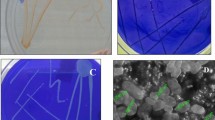Abstract
This work aimed at evaluating the conditions of growth and the recovery of total carotenoids produced by Sporidiobolus salmonicolor (CBS 2636). Optimization of carotenoid production was achieved by experimental design technique. A Plackett–Burman design was used, followed by a complete second-order design, to optimize the concentration of total carotenoids in a conventional medium. Maximum concentration of 1,019 μg l−1 of total carotenoids was obtained in a medium containing 40 g l−1 glucose, 10 g l−1 malt extract, and 14 g l−1 peptone, at 180 rpm, 25 °C, and initial pH of 4.0. So far, no previous systematic study using microorganisms of the genus Sporobolomyces (formerly Sporidiobolus) for production of carotenoids has been reported. In this study, very good yields of carotenoids (1 mg l−1) could be obtained after optimization of fermentation medium and operation conditions.



Similar content being viewed by others
References
Aksu, Z., & Eren, A. T. (2005). Carotenoids production by the yeast Rhodotorula mucilaginosa: Use of agricultural wastes as a carbon source. Process Biochemistry, 40, 2985–2991.
Aksu, Z., & Eren, A. T. (2007). Production of carotenoids by the isolated yeast of Rhodotorula glutinis. Biochemical Engineering Journal, 35, 107–113.
Botella-Pavía, P., & Rodríguez-Concepción, M. (2006). Carotenoid biotechnology in plants for nutritionally improved foods. Physiologia Plantarum, 126, 369–381.
Buzzini, P., & Martini, A. (2000). Production of carotenoids by strains of Rhodotorula glutinis cultured in raw materials of agro-industrial origin. Bioresource Technology, 71, 41–44.
Buzzini, P., Martini, A., Gaetani, M., Turchetti, B., Pagnoni, U. M., & Davoli, P. (2005). Optimization of carotenoid production by Rhodotorula graminis DBVPG 7021 as a function of trace element concentration by means of response surface analysis. Enzyme and Microbial Technology, 36, 687–692.
Chen, D., Han, Y., & Gu, Z. (2006). Application of statistical methodology to the optimization of fermentative medium for carotenoids production by Rhodobacter sphaeroides. Process Biochemistry, 41, 1773–1778.
Davies, B. H. (1976). Carotenoid. In T. W. Goodwin (Ed.) Chemistry and Biochemistry of Plant Pigments. New York: Academic.
Davoli, P., Mierau, V., & Weber, R. W. S. (2004). Carotenoids and fatty acids in red yeasts Sporobolomyces roseus and Rhodotorula glutinis. Applied Biochemistry and Microbiology, 40, 392–397.
Fang, T. J., & Chiou, T. Y. (1993). Optimization of cultivation and astaxanthin production by a mutant of red yeast. Journal of Fermentation Bioengineering, 75, 466–469.
Haaland, P. D. (1989). Experimental design in biotechnology. New York: Marcel Dekker.
Johnson, E. A., & An, G. H. (1991). Astaxanthin from microbial sources. Critical Reviews in Biotechnology, 11, 297–326.
Maldonade, I. R. (2003). Production of carotenoids by yeasts. Ph.D. Thesis in Food Science, Faculty of Food Engineering, University of Campinas, SP, Brazil.
Shih, C. T., & Hang, Y. D. (1996). Prodution of carotenoids by Rhodotorula rubra from Sauerkraut brine. Lebensmittel-Wissenschaft & Tecnology, 29, 570–572.
Silva, C., Cabral, J. M. S., & Keulen, F. V. (2004). Isolation of a β-total carotenoids over-producing soil bacterium, Sphingomonas sp. Biotechnology Letters, 26, 257–262.
Simpson, K. L., Chichester, C. O., & Phaff, H. J. (1971). Carotenoid pigments of yeast. In A. H. Rose, & J. S. Harrison (Eds.) The Yeasts(2nd ed.). New York: Academic.
Somashekar, D., & Joseph, R. (2000). Inverse relationship between carotenoid and lipid formation in Rhodotorula gracilis according to the C/N ratio of the growth medium. World Journal of Microbiology and Biotechnology, 16, 491–493.
Valduga, E. (2005). Production of volatile organic compounds and carotenoids by Sporidiobolus salmonicolor CBS 2636. Ph.D. Thesis in Chemical Engineering, Federal University of Santa Catarina, Florianópolis, SC, Brazil.
Author information
Authors and Affiliations
Corresponding author
Rights and permissions
About this article
Cite this article
Valduga, E., Valério, A., Treichel, H. et al. Optimization of the Production of Total Carotenoids by Sporidiobolus salmonicolor (CBS 2636) Using Response Surface Technique. Food Bioprocess Technol 2, 415–421 (2009). https://doi.org/10.1007/s11947-008-0066-x
Received:
Accepted:
Published:
Issue Date:
DOI: https://doi.org/10.1007/s11947-008-0066-x




